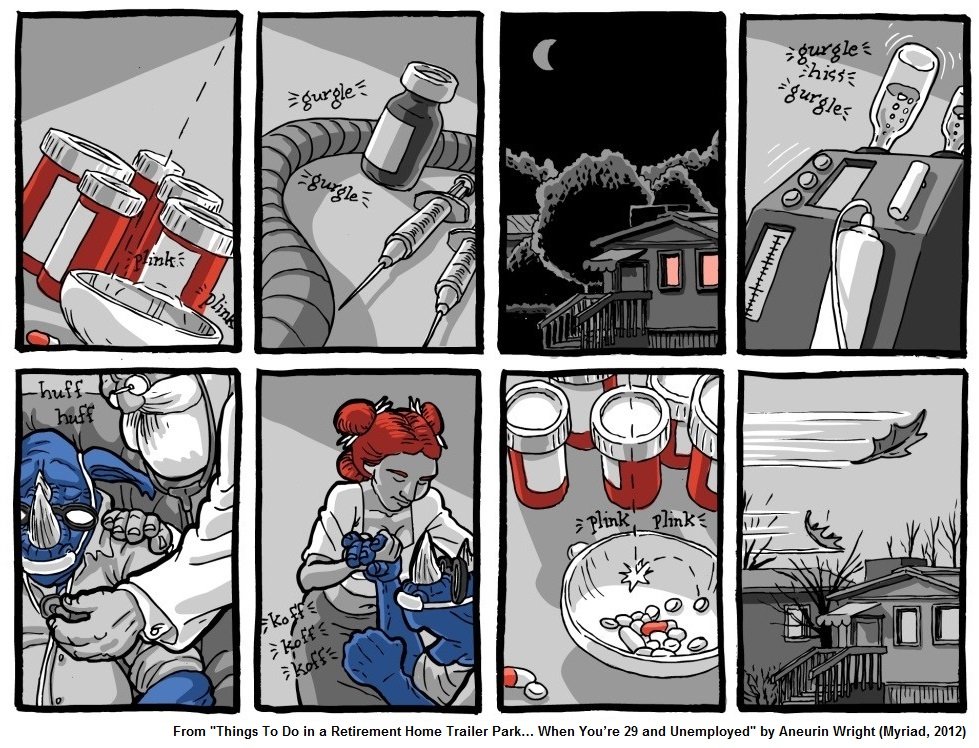Insights into Illness
by Brian Callendar
In our Durham exhibition you’ll see a reprint of a page from the graphic memoir Things To Do in a Retirement Home Trailer Park… When You’re 29 and Unemployed by Aneurin Wright which portrays the relationship of a son and his father (Neil), who suffers from end-stage COPD. It captures the experience of both patient and carer living with a respiratory condition. It typifies the emerging field of graphic medicine where a comic-book style is used to convey the experience of health and illness.
The extract below is from a longer piece by Brian Callendar, originally published on the Life of Breath blog, which introduces graphic medicine using this book as a striking example. To read the full post and see more images from the book simply follow the link at the end of this excerpt.

Graphic Medicine is an emerging field that utilizes the medium of comics to convey the many facets of the experience of health and illness. Graphic medicine is broadly defined as the “intersection between the medium of comics and the discourse of healthcare” and captures a broad range of works and practices exploring the use of comics to depict, analyze, and understand health, illness, and the practice of medicine. As comics scholar Hillary Chute notes, “stories about illness and disability use the show-and-tell aspect of comics so basic to its hybrid form to reveal hard-to-convey truths about sickness or ability” (from p.240 of her book Why Comics? 2017). The interplay between image and text inherent to comics provides a diagrammatic and simultaneous way to express both the bold and subtle features of an experience, including emotions, sensations, and thoughts, within the broader context in which the experience occurs, including relationships to the physical environment and other people. Physical, cognitive, and emotional aspects of health and illness can be expressed and rendered, through text and image, in creative ways to make their relationships and imperceptible features more apparent to the reader. Graphic medicine allows illness narratives to reach their full effect by not only taking advantage of the medium’s capacity to simultaneously depict multiple internal and external narratives but also to manipulate space and time to amplify narrative impact.
For these reasons, the creation and reading of graphic illness narratives aligns more closely to the realities of the illness experience and provide useful insight for educational, therapeutic, historical, and recreational purposes.
When it comes to the intersection of breathlessness and graphic medicine, the graphic memoir Things To Do in a Retirement Home Trailer Park… When You’re 29 and Unemployed by Aneurin Wright is an exemplar of how comics can capture the experience of living with a respiratory condition. The work portrays the relationship of a son and his father (Neil), who suffers from end-stage COPD and is enrolled into hospice. The deterioration of Neil’s condition and death is deftly captured by the interplay between images and text as the story unfolds. Additionally, Wright utilizes the plasticity of the comics form to anthropomorphize the main characters. For reasons that reveal themselves later in the book, Wright depicts himself as a Minotaur and his father as a rhinoceros to layer additional meaning into the narrative.
Read the full post on the Life of Breath blog
Brian Callender is an internal medicine physician from the University of Chicago interested in the health humanities, with a focus on the theory and practice of “graphic medicine” to understand and improve our understanding of health, illness and the delivery of healthcare.



